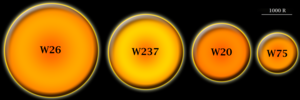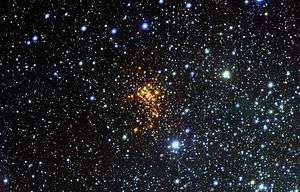Westerlund 1-237
Westerlund 1-237 or Wd 1-237 is a possible red supergiant (RSG) in the constellation of ara. It is one out of 4 known red supergiants in the Westerlund 1 super star cluster, although its outlying position, spectrum, and parallax, suggest it could be a foregound giant.[5] As a red supergiant, it would be one of the largest known stars.[4]
| Observation data Epoch J2000 Equinox J2000 | |
|---|---|
| Constellation | Ara |
| Right ascension | 16h 47m 03.11s[1] |
| Declination | −45° 52′ 19.0″[1] |
| Apparent magnitude (V) | 19.008 |
| Characteristics | |
| Evolutionary stage | either a red supergiant or a foreground giant[2] |
| Spectral type | M3Ia |
| Apparent magnitude (B) | 22.8 |
| Apparent magnitude (J) | 5.075 |
| Apparent magnitude (H) | 3.01 |
| Apparent magnitude (K) | 2.18 |
| Apparent magnitude (G) | 11.3245 |
| Apparent magnitude (R) | 13.634 |
| Astrometry | |
| Proper motion (μ) | RA: -4.379[1] mas/yr Dec.: -1.555[1] mas/yr |
| Parallax (π) | 1.6415 ± 0.2608[1] mas |
| Distance | 623[3] or 3,000[4] pc |
| Details | |
| Radius | 216[3] or 1,245[4] R☉ |
| Luminosity | 7,178[3] or 234,000[4] L☉ |
| Temperature | 3,605[3] or 3,600[4] K |
| Other designations | |
Westerlund 1 W237, Westerlund 1 BKS B, 2MASS J16470309-4552189 | |
| Database references | |
| SIMBAD | data |
Physical characteristics

Westerlund 1-237 is classified as a luminous cool supergiant emitting most of its energy in the infrared spectrum.[6] It is sorrounded by a radio nebula which is similar in mass to those of Westerlund 1-20 and Westerlund 1-26, and moreover directly comparable to that of VY Canis Majoris. The elliptical structure of this nebula however indicates that it has been less affected by the cluster wind of Westerlund 1 (W20 and W26 have pronounced cometary shaped nebula). The outflow velocity for the RSG wind is assumed to be around 30 km/s. The nebula itself seems to have a mass of 0.07 M☉ and a radius of about 0.11 parsecs. This results in a kinematic age around 3,600 years and a time averaged mass loss rate of 2×10−5 M☉ per year.[7]
The star occupies the upper right corner of the Hertzsprung-Russell diagram. With an effective temperature of 3,600 K and a bolometric luminosity of 234,000 L☉, the radius of Westerlund 1-237 would be 1,245 times the solar radius (R☉), which would corresponds to a volume 1.93 billion times bigger than the sun. If placed at the center of the Solar System, the star would engulf the orbit of Jupiter.[4][lower-alpha 1]
Distance
The distance of Westerlund 1 is assumed to be around 8,500+2,000
−1,300 light years or 2,600+600
−400 parsecs[8] based on it being commonly thought of as a member of the Westerlund 1 star cluster (the elliptical shape of its nebula indicates that it might not be near the center of W1, while other RSGs like W20 and W26 are).[7] Another source suggests a similar distance of 3,000±500 parsecs.[4]
Westerlund's 1987 analysis assigned a spectral type of M6+ III to W1-237 and considered it to be a foregound giant with a luminosity only around 1,000 L☉.[2] Gaia Data Release 2 gives a parallax of 1.64±0.2608 mas for W1-237,[1] implying a distance of 623+139
−96 pc and a luminosity of 7,178–7,379 L☉ with a corresponding radius of 216 R☉.[9][3]
See also
Notes
References
- Brown, A. G. A.; et al. (Gaia collaboration) (August 2018). "Gaia Data Release 2: Summary of the contents and survey properties". Astronomy & Astrophysics. 616. A1. arXiv:1804.09365. Bibcode:2018A&A...616A...1G. doi:10.1051/0004-6361/201833051. Gaia DR2 record for this source at VizieR.
- Westerlund, B. E. (1987). "Photometry and spectroscopy of stars in the region of a highly reddened cluster in ARA". Astronomy and Astrophysics. Supplement. 70 (3): 311–324. Bibcode:1987A&AS...70..311W. ISSN 0365-0138.
- Messineo, M.; Brown, A. G. A. (2019). "A Catalog of Known Galactic K-M Stars of Class I Candidate Red Supergiants in Gaia DR2". The Astronomical Journal. 158 (1): 20. arXiv:1905.03744. Bibcode:2019AJ....158...20M. doi:10.3847/1538-3881/ab1cbd.
- Fok, Thomas K. T.; Nakashima, Jun-Ichi; Yung, Bosco H. K.; Hsia, Chih-Hao; Deguchi, Shuji (2012). "Maser Observations of Westerlund 1 and Comprehensive Considerations on Maser Properties of Red Supergiants Associated with Massive Clusters". The Astrophysical Journal. 760 (1): 65. arXiv:1209.6427. Bibcode:2012ApJ...760...65F. doi:10.1088/0004-637X/760/1/65.
- "APOD: 2017 June 20 - The Massive Stars in Westerlund 1". apod.nasa.gov. Retrieved 2020-06-21.
- "Cl* Westerlund 1 W 237". Simbad.
- Dougherty, S. M.; Clark, J. S.; Negueruela, I.; Johnson, T.; Chapman, J. M. (2010-02-01). "Radio emission from the massive stars in the galactic super star cluster Westerlund 1". Astronomy & Astrophysics. 511: A58. arXiv:0912.4165. Bibcode:2010A&A...511A..58D. doi:10.1051/0004-6361/200913505. ISSN 0004-6361.
- Aghakhanloo, Mojgan; Murphy, Jeremiah W.; Smith, Nathan; Parejko, John; Díaz-Rodríguez, Mariangelly; Drout, Maria R.; Groh, Jose H.; Guzman, Joseph; Stassun, Keivan G. (2020-02-21). "Inferring the parallax of Westerlund 1 from Gaia DR2". Monthly Notices of the Royal Astronomical Society. 492 (2): 2497–2509. arXiv:1901.06582. Bibcode:2020MNRAS.492.2497A. doi:10.1093/mnras/stz3628. ISSN 0035-8711.
- Bailer-Jones, C. A. L.; Rybizki, J.; Fouesneau, M.; Mantelet, G.; Andrae, R. (2018). "Estimating Distance from Parallaxes. IV. Distances to 1.33 Billion Stars in Gaia Data Release 2". The Astronomical Journal. 156 (2): 58. arXiv:1804.10121. Bibcode:2018AJ....156...58B. doi:10.3847/1538-3881/aacb21.
